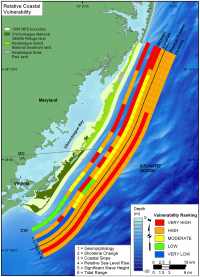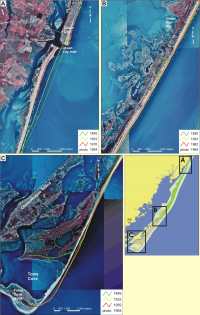

Map of Coastal
Vulnerability
  |
DISCUSSION
 |
| Figure 5. Relative Coastal Vulnerability for Assateague Island National Seashore. Click on figure for larger image. |
The data within the coastal vulnerability index (CVI) show variability at different spatial scales (Figure 5). However, the ranked values for the physical process variables vary little over the extent of the shoreline. The value of the relative sea-level rise variable is constant at high vulnerability for the entire study area. The mean significant wave height vulnerability is very high to high, and the tidal range is high vulnerability.
The geologic variables show the most variability and thus have the most influence on the CVI value (Figure 5). Geomorphology in the park includes high vulnerability barrier island shoreline with dune ridges separated by very high vulnerability washover-dominated low areas. Vulnerability assessment based on historical shoreline change trends varies from very low to very high (Figure 4 A -C). Regional coastal slope is in the high vulnerability range for the extent of Assateague Island.
 |
| Figure 4. Historic Shoreline positions for A) northern, B) south-central, C) and southern Assateague Island. Click on figure for larger image. |
The most influential variables in the CVI are geomorphology, shoreline change, and significant wave height; therefore they may be considered the dominant factors controlling how Assateague Island will evolve as sea level rises. Geomorphology and significant wave height only vary between high and very high vulnerability, whereas shoreline change ranges from very low to very high.
Because of the importance of habitat and the dynamic nature of Assateague, concern about erosion, storm surge breaching of the barriers, future sea level rise, and mainland flooding, planning is underway by Federal and State agencies to address these issues. Alternatives such as large-scale nourishment of the beach and dunes along Assateague Island are being considered. Implementation of beach nourishment could alter the CVI results presented here.
Back to Top
|

|




